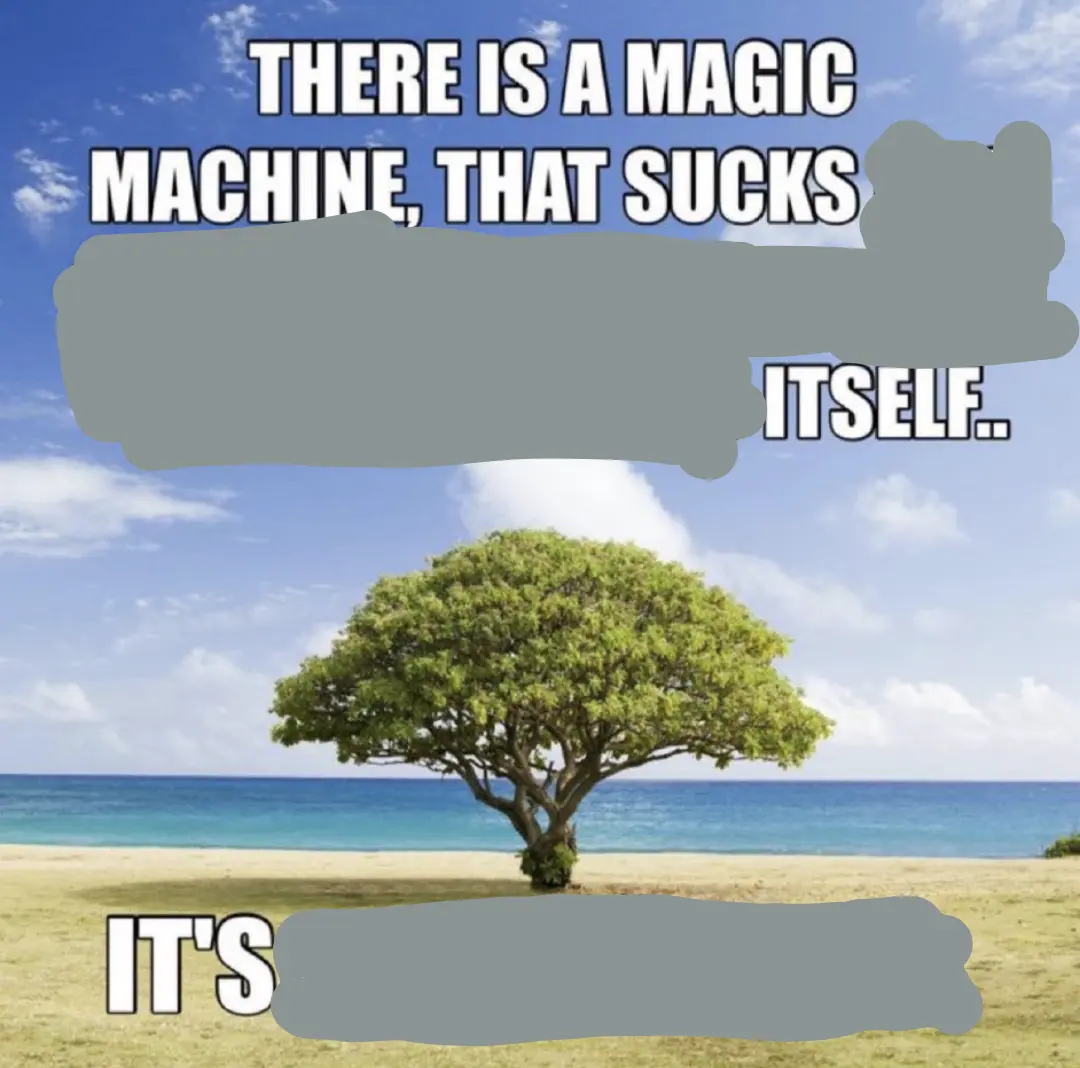While I appreciate the sentiment, this is straight from grandma’s facebook feed.
Broken clock, etc.
that’s all OP posts anyway. FB meme “humour “
Slap a cackling minion in the corner for maximum effect.
Grass does that too. And probably better.
*Grass does not equal lawns. Go to the prairies, friends.
You need actual biomass to physically exist, only then is carbon actually bound. Trees have much denser cellulose and stay around for longer. Ultimately, though, the answer is both. And bushes and shrubs. Just build up a whole forest. The denser you can make it, the better.
Almost every plant is carbon neutral in its life cycle, it’s a great sentiment, but it doesn’t work in the end.
I wonder how carbon-negatove a bamboo forest would be if you harvest it, turn it into charcoal (or bury in a bog or something?), rinse and repeat. Afaik charcoal sinks carbon fairly effectively (???), unless you burn it obviously.
Just make it your kids problem, sure that’s worked so far.
You keep acting like trees are harming humans. Personally I haven’t been harmed by a tree before and I’m happy everytime I see one. They’re much nicer to look at, less noisy, require less roads and provide more shade than cars. Also they don’t burn fossils.
Following your logic, since trees are carbon neutral and presumably only create problems for future generations, we’d have to go and remove all trees that exist on Earth. Sounds like something the woodcutting lobby would say.
I think they’re saying that since there’s are neutral, focusing on them to fix or climate is a distraction from what we really need to do.
Namely stop putting CO2 into the atmosphere.
We’re still more forest, but it’s going to be hard to get that off the climate is too far gone to safely sustain one, like how so much of Canada is burning at the moment (and does now pretty much every summer).
deleted by creator
This is what I was going by. I’ve heard similar said before.
Literally from people selling you it though lol. It’s possible, but I think the greater insect life more diverse lawns facilitate is a better net overall for the world.
Grass lands are not lawns.
Ok good point.
And peat bogs!
Trees burn though. When grass burns it grows back in a heartbeat because it’s biomass is underground
People don’t know prairie plant root systems can go more than a dozen feet below ground
Not a lot of people on this site touch grass, let alone think about it.
Trees are great and all but there’s much better carbon sinks, algae is a big one.
You mean the stuff that grows in what we use as global garbage sink?
“Aaaahhh, the ocean… the toilet of the world!”
- Homer Simpson
yep, and a lot more places too! Pretty much anywhere that has some level of moisture has algae
Doing some back of the envelope calculations we have put about 1.6 trillion tons of CO2 into the atmosphere since the industrial revolution. Latest estimates put the number of trees on earth at around 3 trillion. Looking at how much CO2 a tree takes up puts the average around 600lbs over the first twenty years. So combing all this if we want to plant enough trees to take up all the excess CO2 we would need about 5.3 trillion more trees, or almost double the total number of trees on the planet.
This is simply not achievable in a fast enough time span to make a difference. Nevermind that I was being super optimistic with all my calculations and the real number needed is likely much higher still.
It is simply a necessity to develop better methods to pull CO2 directly from the air and to do it on the same scale that we have been releasing CO2.
It is simply a necessity to develop better methods to pull CO2 directly from the air and to do it on the same scale that we have been releasing CO2.
Instead of wasting energy and effort trying to remove existing CO2 from the air, people should instead spend effort on not releasing more carbon dioxide into the air. It’s similar to things like plastic waste where it’s better not to create any waste than to recycle plastic, or the same as private transport where it’s better to not have or drive a private car or private jet than to drive or fly energy efficient.
There’s about 0.05% CO2 in the air. So pulling CO2 from the air is as inefficient as it gets. It’s somewhere between moving to Antarctica to bathe in the sun and using the full moon for solar panels.
The theoretical best place to sun bathe is, unsurprisingly, on the sun! Similarly it’s best to scrub CO2 at the source, meaning the exhausts! Filter it at motors, kilns, chimneys, etc.
We have to do both. If today our emissions went to zero we would still see more warming because of all that CO2 we’ve already released. First priority is to get to net zero so we can stop making the problem worse, then we have to remove all the CO2 we released. We have the technology now to do step one it’s just a matter of scaling it up. While we work on step one we need to do the research on the best way to do step two so when we get to that point we have something ready to go. Pulling CO2 out of the air is going to be inefficient no matter what just from the physics of the problem but it still needs to be done and the energy to do so has to come from renewables.
One proposed solution is using the excess energy production during peak hours for renewables to sequester carbon which would help but likely only be a small initial step in the right direction.
I think that’d be too little “bang for your buck” to be worth it. Investments might make matters even worse. After all, at some point building more and more energy generators for less and less efficient things will have severe drawbacks. Those energy generators aren’t built for free, nor are the machines necessary to build them, let alone the inefficient machines used to scrub co2 from the air.
I believe an active push towards carbon dioxide removal can be a double edged sword and even dangerous, especially if it relies on electricity (as opposed to actions which provide other benefits and help nature recover, like restoring forests, marshes/wetlands, etc.). As long as people want to do it with electricity, the demand for fossile fuels for electricity is bound to increase one way or another. Even if one country wants to do it 100% clean and could produce enough energy for direct air capture and all of its inhabitants are trustworthy, they’re still going to be in competition with other countries - and if country A happens to own all the materials to build things like batteries or wind turbines, then country B will struggle and instead rely on gas or coal plants.
Some lobbyists might tell you otherwise, but there’s definitely many many more important than things to invest time/effort/money into. Social care, social injustice, public transportation, energy storage/stability, natural disasters, peace, climate refugees, etc.
I wonder how many years of carbon accumulation we have burned so far. The oil we have burned is 800 million years of algae? That’s just a wild guess. Extinction is a normal natural process. Most of the species that have existed have gone extinct, we should start trying to come to terms with knowing that it is our turn to join them. Collectively, we have been and will remain unwilling to do what it takes to save ourselves.
we should start trying to come to terms with knowing that it is our turn to join them
That’s just called “death”. Everything that lives today is descended from an organism that existed before it. The idea that humans would just… stop existing, rather than producing variants that were more acclimated to the subsequent iteration of earth’s biome seems unlikely, particularly given how rapidly we’ve learned to adapt to changing ecological conditions.
Given that humans - as a species - survived the Ice Age, they’ll likely survive the Heat Age in some form or another.
It is simply a necessity to develop better methods to pull CO2 directly from the air and to do it on the same scale that we have been releasing CO2.
Exactly this. The oil we burn today needs to be re-made tomorrow and put back into the hole it was pumped out of.
Or we live with it and just stop producing more.
It is simply a necessity to develop better methods to pull CO2 directly from the air and to do it on the same scale that we have been releasing CO2.
No it’s not. In fact, it’s impossible. Turning C02 into other stuff takes energy. There’s no perpetual motion machine you can use to burn carbon, turn the carbon back into oil, and gain energy. It’s impossible. The only solution is to reduce our demand for fossil fuels, and increase our excess energy generation enough that we can begin undoing the past 100 years of damage through capture after we’ve already prevented worsening of the problem.
Nowhere did I say or imply that capturing CO2 is a net positive of energy. It is in fact a huge energy sink. If you aren’t using renewables to power CO2 capture then you’re just making the problem worse.
How do we get these “trees” into a decentralized block chain with integrated AI? Only then will we get people to carelessly throw money at them.
Its capitalism, no one will invest in technology that can not be patented.
We all die to preserve the market.
Oops, it turns out mass extinction event really hurts the market.
It’s going to be so dumb when that is the actual argument that wins over corporate America.
Yeah you fucking idiots, ruling the ashes defeats the purpose.
I’m saddened by the deforestation I’ve seen in my hometown. A lot of kids would go to hang out and play in the forests, but it looks like only the designated protected areas some distance off will be left in the future. Having wildlife in one’s back yard will be reduced to a novelty.
but does it make the line go up tho
Does it make line go up faster than last year?
If you cut it down
Trees only store CO² for a limited time. Then you need to somehow store it in the holes we got the oil out from. I prefer algae.
Algae or hemp. Hemp stores 85% of the carbon in its roots, so you can use the rest of the plant. Just collect the roots and compress them to a density that will NOT float and dump the root cubes into the Mariana Trench. That carbon will be trapped for a few tens to hundreds of millions of years. Also one acre of hemp pulls 10 times more carbon out of the air that one acre of trees does per harvest, and you can harvest the hemp 4 times a year as opposed to once every 60 years.
Just collect the roots and compress them to a density that will NOT float and dump the root cubes into the Mariana Trench.
Or throw them into a strip mine or oil well seal it up. Not like we don’t have a ton of giant holes in our ground after a century of fossil fuel extraction.
I would be worried about seepage into and out of those holes, but I suppose it is unlikely to turn into something toxic…
Yeah, algae has problems with sensibility to temp and bacteria and so on. And my duvet cover out of hemp thermo-regulates itself, no sweat.
This. Also, they’re kinda slow. Unfortunately, we’re in need of solutions that (in addition to using plants) work much, much faster.
You don’t have to go THAT far, you can bury it over time through regenerative agriculture. Also, crazy I know, you can build durable structures with them. That said, the substantial majority of carbon sequestered by forests is in the soil as part of the lifecycle of the forest, therefore preserving trees, especially forests is extremely vital much more so than planting new trees. Restoring forests and wetlands is also vital but It takes a long time for a forest ecosystem to develop, and if you’re trying to just convert land to rapidly sequester CO2, bamboo plantations and algae farms are faster.
Actually, they’re starting to do just that. It’s called wood vaulting. Can’t tell if the lack of decomposition is a pro or a con, though.
Wetlands wetlands wetlands wetlands wetlands!
Cut it down and build with it too. I wonder if this community dislikes that thought.
I was surprised to not see this until the very bottom. There’s usually a panel about it in a lot of the environment and conservation conferences I go to for work. Storing the carbon in tree trunks and the using that wood in to build the housing that’s required is a long term carbon sink.
Sure it just makes it someone else’s problem, wood like almost all other materials has a finite period where it’s safe to use. Eventually all of it will decay and become co2 again.
But when it decays you could replace it with more wood, and then if more housing is ever needed you pull more carbon out of the air to make the wood for that. Not that it’s the end all solution but actually replanting forests and increasing the amount of wood in structures, and replacing plastic furniture with wood, it all could help. Every lever matters
Buildings made today really should last for a long friggin time. I really don’t see why any modern house ever needs to be torn down.
You can use chemicals to preserve the wood, but there’s environmental issues with that, it also increases the cost, it’s not safe to inhale while cutting, requires post treatment, etc.
Yes they should last 3-5 decades and some could last a century, just like some existing wood buildings have. But modern homes are weird, they are meant for efficiency over being “structurally sound”. By that I mean they’ve figured out essentially the bare minimum needed to build and have the right safety margins. So yeah build with 2x8s, they’ll last longer than 2x4s, but it’s also not environmentally “conscious” at the same time. So rock hard place.
We still have homes from a century ago. The ones built today should last wayyy beyond that. And century homes are being torn down not because of the wood, but because they are way too small. I have a really hard time thinking that modern homes are going to be seen as too small in 100 years. Likewise I think you’re out to lunch thinking modern homes are going to structurally fail.
Survivorship bias, yes some last, most do not.
I’m not saying they’re going to fail, that’s why they have a life span that they last before they require replacement, or you could find an engineer to continually sign off every x years to deem it safe.
There codes, laws and regulations for a reason, I guess you could argue against the communal knowledge of every industry if you want. But houses built nowadays aren’t overbuilt like they used to be, that’s just how code have adopted to be as efficient as possible, instead of here, wood aplenty. More wood also requires a stronger foundation since it weighs more and requires more support. So it’s all snowballing in that regard. You can’t just put a 2x8 wall on foundation meant for 2x4, that requires double the size of foundation, just like that.
Survivorship bias from a hundred years ago. We build things a lot better now.
You think I’m arguing against the communal knowledge of every industry? I’m arguing with the communal knowledge of every industry. We have way more knowledge, have better materials, know how to build things better, and we do build things better than before. I don’t think we’re going to agree, so I’m out.
It’s only temporary storage, wood, like almost all other materials has an expected life expectancy. Some will last, but most will decay and require replacement.
All solutions that involve plants are temporary, it’s just delaying it for further generations, doesn’t solve anything.
Can you not turn it into charcoal and bury it? I think that has a very long lifetime.
Just delays it more, it does eventually decay. I think the only solution I’ve come across that I haven’t seen the math against, would be to use it for rockets and eject the co2 essentially. But could that be carbon positive, I would love to know, but at the same time, we only just found metal particles in the atmosphere that are linked from space craft and re-entry.
So we’ve already done irreversible damage with rocket launches… so what don’t we know next?
If you really want carbon capture protect your wetlands. They’re truly the best.
“Imagine if trees gave off Wifi signals, we would be planting so many trees and we’d probably save the planet too. Too bad they only produce the oxygen we breathe.”
– Tarun Sarathe
There are all these micro machines that suck up a lot more C02 it is called hemp
Trees are great but part of a larger picture of ecosystems that do a great job of taking co2 out of air and building with it. Soil is a huge deal for how effective ecosystems are at scrubbing co2. All plants die off and decay but much of their carbon can get sequestered into the soil. Healthy soil has deeper microbes and insects breaking down and sequestering better, and improving future plants growth.
Basically stop lawnmowing and industrial farming.
A tree absorbs about 25 kg of CO2 per year. A human breathes out about 250 kg of CO2 per year.
Trees are great, but not all that efficient. To deal with the amount of CO2 humanity is currently producing, we’d need a whole lot more of them.
That’s just breathing.
A gallon of gas is nearly 9kg.
A ton is 1000kg. And it costs about $160 to capture it. So $1.44 per gallon to recapture it’s CO2.
Costs are USD.
Could you imagine a 40% tax on gasoline to pay for carbon capture?
We’re all fucked.
Not only can I imagine it, I think we should go for it. The goal ought to be one cylinder per person, a family of four gets driven around with a 1.6L naturally aspirated V4 engine.
Keep it balanced between simple and efficient.
Mormons eyeing up a W16 Bugatti as their next motor vehicle purchase…
Their church certainly appears to be able to afford it 🙄
Luckily for us it’s not just trees though of course. there’s like 400 something trees per person though and many other plants and organisms that also help as carbon sinks. Grasses and other plants cover the ground and sink tons of CO2. It’s pretty cool to look up how much CO2 capture per different organisms like an acre of grass etc.
Yeah, nature is great. If all it had to handle were billions of people breathing we’d have no issues.
The problem is that modern machines are extremely efficient at dumping CO2 into the atmosphere, but as great as trees are, they’re not all that efficient at removing it. So, if we want to keep CO2 at survivable levels, we either need fewer CO2-emitting machines (ideal) or a machine that takes CO2 out of the atmosphere (so far, impossible at scale). Simply relying on trees isn’t going to cut it.
So it turns out that trees are actually carbon neutral, and aren’t carbon sinks like previously assumed.
The tree does store co2 in a sense, but as much co2 is also produced by the tree during its life cycle, it’s leafs are eaten by bugs, the leaves that fall to the ground decompose and also provide feed to microorganisms.
Now once the tree is dead, it also decomposes releasing co2 as well as providing food for bugs and organisms that all turn it to co2 as well.
Nature is wonderful, but they were completely wrong about trees scrubbing co2 from the atmosphere.
If the tree dies or is cut down and burnt, then absolutely, yeah. But a tree can survive for many decades, which is time when the CO2 is not in the atmosphere. Ultimately, the solution is to plant more trees and not cut them down until enough CO2 is bound.
You can turn it into biochar. (turn it into carbon) the carbon becomes stable for centuries and you can put it in compost to boost beneficial bacteria, use it to filter runoff, etc. You can just crush it and just throw it on the grass. You get about 50% stable carbon from whatever biomass you use.
A solution for a small but notable chunk of the problem perhaps.
There’s no way that we can solve the entire problem that way.
Before human civilisation trees covered entire nations that are mostly bare today. Humanity cut down a lot of trees during prehistory, and it presumably had an impact on the climate. But it was nothing compared to our fossil fuel burning.
And that’s pretty much the upper limit of what we can dream of achieving, realistically it seems unlikely that the UK will ever go back to mostly woodland, what countries will? Its have to be most of the countries in viable climates, and probably means most farmland, and we’d still just make a small blip compared to the scale of the problem.
Once we’re truly carbon neutral, and we’ve covered the world in trees, we’ll still have more carbon in the atmosphere, a lot more, and I guess a few billion starving people since we’ve turned the farms into forests that can’t sustain our population, and we’d still be a few degrees warmer.
We need a way to turn co2 back to solid carbon that won’t decompose, that’s the only way out long term (lower priority than carbon neutral of course).
Not to say that planting trees is bad or anything, it’s just not a solution to the level of problem we’ve created, it never could be.
You could bury the wood underground where oxygen doesn’t reach, or as someone else already suggested, turn it into biochar before you do it.
But whatever we do, we need an efficient way of getting the CO2 out of the atmosphere and there’s just no way that we’re going to beat trees in that, because it is an endothermic process and whatever machine we might build will require building that machine (at large scale) and will have inefficiencies all over the place.
So, planting as many trees as possible is always the first step we have to take.Of course, trees should be planted, but the notion that they are an expedient way of decarbonizing the atmosphere is plainly wrong. Had nature optimized plant life to remove carbon from the atmosphere, there would be no CO2, no plants, and the planet would be a snowball instead of the vibrant, warm (too warm) climate we have today. Nature maintains stasis - and therefore life - by avoiding carbon sequestration.
You may have seen the Keeling Curve, the “graph of the accumulation of carbon dioxide in the Earth’s atmosphere based on continuous measurements taken at the Mauna Loa Observatory on the island of Hawaii from 1958 to the present day.” Notice that it goes up and then down in Seasonal Variation. This is because, during the summer months in the Northern hemisphere, all the plant life decarbonized the air to form new leaves and greenery. Then, in the winter, all the leaves fell back to the ground where they were consumed by fungi and detrivores and converted back to CO2.
Suppose we stopped producing fossil fuels tomorrow. The Keeling Curve would still have seasonal variation, but it would be against a constant mean, rather than the current rising one. If we then just planted more trees, the seasonal variation would increase, perhaps, but the mean would remain more or less constant. While beneficial, none of the planting would make more than a dent in the hundreds of billions of tons of anthropogenic CO2 in the atmosphere. The potential for soil sequestration is on the order of 1 Gt/year.[source] That doesn’t mean we shouldn’t practice sustainable agriculture and forestry, rather we should, but it won’t reduce our carbon debt or start to reverse climate change. Believing that it will is just magical thinking, coincidentally an inadvertent implication of the meme.
Given that nature is (almost) perfectly inefficient at long-term carbon sequestration, it would seem that effective, long-term decarbonization of the atmosphere on any scale short of millennia has to include mechanical means, no matter how inefficient such means may appear.
The thing is, you and everyone arguing against me here, have yet to offer a concrete solution that’s better. I don’t care how futile trees might be, they’re the most efficient, most scalable solution that I’m aware of. And not doing anything due to trees being futile, that’s completely fucking pointless, too. If we die, we might as well die fighting, even if it merely makes the remaining years just a little less bad.
You make a good point. If there were no potential solution, trees (i.e. sustainable agriculture) would be the best solution. It would take a few hundred years but we would get back to pre-industrial levels at zero emissions.
The potential solution is direct air capture. Although there are many forms, I am fond of the method proposed by Klaus Lackner. By making a large number of CO₂ scrubbers, as opposed to a few very large ones (like Climeworks), the economics of carbon removal get very easy, very fast.
A 1 m² area that gets an average 2 m/s breeze through it sees about a gram of CO₂ pass through every second. This is about 100 kg of CO₂ per day. So let’s make a machine that catches CO₂ from a 2 × 5 m area and catch 1 t per day, or 300 t per year. For this machine to pay off its carbon debt, it’s going to need to be around for a while, say 10 years. What happened during those 10 years? 3 kt went out of the atmosphere for good. If you liquefied the CO₂, this would fill 3 McMansions.
Lackner seems to think we can build this machine for $100k. Now we have a price of $30/t of CO₂ captured. As it stands, we need to get about 1,000 Gt of CO₂ out of the atmosphere to stabilize the climate, so we need to build $30T worth of these machines. How could we possibly afford that? Well, we would spend ~$1T on this per year for about 30 years.
Where would that kind of money come from? Sacrifices would be needed, it’s true. I think the biggest would be giving up on war. Global defense budgets add up to this scale of funding, and if the nations of the world decided to put an end to war, we could use the peace dividend to pay for the restoration of the climate. Perhaps there wouldn’t be any other sacrifices needed at all.
If this seems unrealistic to you, that’s ok too. We can still keep war and do things the slow way or (more likely) not do them at all. I suppose a decade-long nuclear winter would also do wonders for global cooling and emission reductions. Personally, though, I would prefer world peace and direct air capture to stabilize the climate.
I think, from your post, you would agree. If we are going to fight, we should fight climate change, not each other, no?
But trees naturally die, they can’t last infinitely, that’s a non existent scenario.
Even if it’s cut down and made into housing, most of it eventually decays (25-30 years usually).
It just doesn’t work in the end.
Are you aware that trees can have offspring and even multiply?
And what do you think happen to those offspring? Eventually it reaches an equilibrium where it produces as much as it scrubs, and eventually as it inevitably does it creates more than it scrubs.
Yes the scientist have thought of this and figured out that it’s carb neutral….
Eventually it reaches an equilibrium
Yes, it will reach an equilibrium if the forest stays the same size, but that equilibrium uses more carbon. If you have a forest where before there was nothing, then you have trees at all different stages of life, all made of carbon.
Every dying tree releasing carbon is replaced by a growing tree absorbing it. The forest is carbon neutral if it’s static, absorbs carbon if it grows and emits carbon if it shrinks.
Uhh no, a forest doesn’t need to grow in size to create more co2, don’t forget all the other organisms that get attracted and offset the size. As it grows so does the organisms it attracts, it will always reach an equilibrium, if it grows, more organisms come and consume the “extra” which is no longer extra.
Its not as simple as everyone try’s to make it to try and make it work, which is literally why scientists have started debunking it and trying to stop all of these carb offset scam forests.
Sorry,
What makes the vast majority of carbon offset forests a scam is that they existed beforehand and nobody was planning to cut them down, so no new carbon is being removed.
Yeah, the actual permanent solution would have been to not unearth all that fossil fuel in the first place. The second-best solution is to bind it in trees.
We could try cutting down trees and burying them underground without (much) oxygen. But just having more trees alive at a time is a lot less effort.
Burying it does what? It still decays and releases the co2 eventually. All you would be doing is making it future generations problem, like what we’ve always been doing, so maybe we need to do so thing different…?
Do you not think that’s been thought of and deemed not viable?
They’re CO2 storages that can provide fruits, shadow, oxygen and other nice things. That’s pretty neat.
Yea CO2 storage and also help cool the vicinity around themselves
Yes temporary, making it a future generations problem… because that’s worked out pretty well so far for our previous generations….
An individual tree is neutral, but a forest is carbon negative as long as it exists.
Untrue.
Just letting a forest grow wild is carbon neutral. The soil reaches a point of saturation. Eventually the dead trees get eaten by detritivores, releasing the captured carbon back into the air.
Keeping it sequestered long term requires burying it deep - the trees would need to be cut down and transported to where bacteria, fungus, and so on can’t eat them.- forest does not exist. Carbon is in atmosphere
- forest grows, carbon is bound up in whatever lives in the forest
- forest reaches steady state, carbon emitted by decomposition is balanced out by new growth
It’s net negative as long as it exists. What I said is true.
It reaches an equilibrium where it’s producing as much as much as its scrubbing at some point though.
And as it dies off it will produce more than it can scrub. All its doing is delaying the issue for someone else to deal with.
click to waste your time















